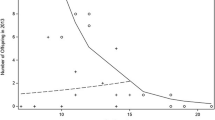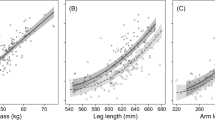Abstract
The reproductive success (RS) of 32 males in a captive group of rhesus macaques (Macaca mulatta) between 1978 and 1992 was determined using paternity exclusion analysis. Dominance rank of each male over age 4 was assessed at the end of each breeding season based on agonistic dyadic interactions. The dominance rank and RS of these males were strongly correlated whether or not subadult males were included. The high reproductive success of males that eventually reached alpha rank is primarily responsible for this outcome. These results support the theory that social dominance has evolved in genusMacaca by sexual selection but some changes in male dominance rank and RS during the 15-year period suggest that priority of access is not the sole focus for such selection.
Similar content being viewed by others
References
Alper, C. A., N. I. Robin, &S. Refetoff, 1971. Genetic polymorphism in rhesus C3 and Gc globulin.J. Immunol., 107: 96–98.
Altmann, S. A., 1962. A field study of the sociobiology of the rhesus monkey,Macaca mulatta.Ann. N.Y. Acad. Sci., 102: 338–435.
Bercovitch, F. B., 1986. Male rank and reproductive activity in savanna baboons.Int. J. Primatol., 7: 533–550.
————, 1992. Re-examining the relationship between rank and reproduction in male primates.Anim. Behav., 44: 1168–1170.
Bernstein, R., S. Robbins, &J. Rall, 1970. Polymorphism of monkey thyroxine-binding prealbumin (TBPA).Endocrinology, 86: 383–390.
Cowlishaw, G. &R. I. M. Dunbar, 1991. Dominance rank and mating success in male primates.Anim. Behav., 41: 1045–1056.
Duvall, S. W., I. S. Bernstein, &T. P. Gordon, 1976. Paternity and status in a rhesus monkey group.J. Reprod. Fertil., 47: 25–31.
Edman, J. C., M. E. Evans-Holm, J. E. Marich, &J. L. Ruth, 1988. Rapid DNA fingerprinting using alkaline phosphatase-conjugated oligonucleotides.Nucleic Acids Res., 16: 6235.
Goodman, M. &R. Wolf, 1963. Inheritance of serum transferrin in rhesus monkeys.Nature, 197: 1128.
Inoue, M., F. Mitsunaga, H. Ohsawa, A. Takenaka, Y. Sugiyama, S. A. Gaspard, &O. Takenaka, 1991. Male mating behavior and paternity discrimination by DNA fingerprinting in a Japanese macaque group.Folia Primatol., 56: 202–210.
Ishimoto, G., 1971. Electrophoretic patterns of red cell NADH diaphorase in macaque monkeys.J. Anthropol. Soc. Nippon, 79: 382–387.
Jeffreys, A. J., V. Wilson, &S. L. Thein, 1985. Hypervariable ‘minisatellite’ regions in human DNA.Nature, 314: 67–73.
Kambah, M. I. &R. E. Ferrell, 1986. A sensitive immunoblotting technique to identify thyroxine-binding globulin protein heterogeneity after isoelectric focusing.Biochem. Genet., 24: 273–280.
McMillan, C. A., 1989. Male age, dominance and mating success among rhesus macaques.Amer. J. Phys. Anthropol., 80: 83–89.
Miller, S. A., D. D. Dykes, &H. F. Polesky, 1988. A simple salting out procedure for extracting DNA from human nucleated cells.Nucleic Acids Res., 16: 215.
van Noordwijk, M. A. &C. P. van Schaik, 1985. Male migration and rank acquisition in wild long-tailed macaques (Macaca fascicularis).Anim. Behav., 33: 849–861.
Prychodko, W., M. Goodman, B. M. Singal, M. L. Weiss, G. Ishimoto, &T. Tanaka, 1971. Starch-gel electrophoretic variants of erythrocyte 6-phosphogluconate dehydrogenase in Asian macaques.Primates, 12: 175–182.
de Ruiter, J. R., W. Scheffrahn, G. J. J. M. Trommelen, A. G. Uitterlinden, R. D. Martin, &J. A. R. A. M. van Hooff, 1992. Male social rank and reproductive success in wild long-tailed macaques. In:Paternity in Primates: Genetic Tests and Theories,R. D. Martin,A. F. Dixson, &E. J. Wickings (eds.), Karger, Basel, pp. 175–191.
Siegal, S., 1956.Nonparametric Statistics for the Behavioral Sciences. McGraw-Hill, New York.
Smith, D. G., 1981. The association between rank and reproductive success of male rhesus monkeys.Amer. J. Primatol., 1: 83–90.
————, 1987. Generational bias in mating in captive groups of rhesus monkeys (Macaca mulatta).Folia Primatol., 49: 212–215.
—, in prep. Male dominance and reproductive success in a captive group of rhesus macaques (Macaca mulatta).Behaviour.
—, in press. Avoidance of matrilineal inbreeding in captive groups of rhesus macaques (Macaca mulatta).Amer. J. Primatol.
———— &C. E. Ahlfors, 1981. The albumin polymorphism and bilirubin binding in rhesus monkeys (Macaca mulatta).Amer. J. Phys. Anthropol., 54: 37–41.
————,B. Rolfs, &J. Lorenz, 1992. A comparison of the success of electrophoretic methods and DNA fingerprinting for paternity testing in captive groups of rhesus macaques. In:Paternity in Primates: Genetic Tests and Theories,R. D. Martin,A. F. Dixson, &E. J. Wickings (eds.), Karger, Basel, pp. 32–52.
Smith, S., 1986. Infant cross-fostering in captive rhesus monkeys (Macaca mulatta).Amer. J. Primatol., 11: 229–237.
Sullivan, P. T., C. Blystad, &W. H. Stone, 1977a. Immunogenetic studies on the rhesus monkey (Macaca mulatta): XI. use of blood groups in problems of parentage.Lab. Anim. Sci., 27: 348–351.
————, ————, & ————, 1977b. Immunogenetic studies of rhesus monkeys: VII. a simple hemagglutination technique for blood typing.J. Immunol. Meth., 14: 31–36.
Tashian, R., M. Goodman, V. Headings, J. DeSimone, &R. Ward, 1971. Genetic variation and evolution in the red cell carbonic anhydrase isozymes of macaque monkeys.Biochem. Genet., 5: 183–200.
VandeBerg, J. &W. Stone, 1978. Biochemical genetics of macaques: II. glucosephosphate isomerase polymorphism in rhesus monkeys.Biochem. Genet., 16: 691–694.
Witt, R., C. Schmidt, &J. Schmitt, 1981. Social rank and Darwinian fitness in a multimale group of Barbary macaques (Macaca sylvanus).Folia Primatol., 36: 201–211.
Author information
Authors and Affiliations
About this article
Cite this article
Smith, D.G. A 15-year study of the association between dominance rank and reproductive success of male rhesus macaques. Primates 34, 471–480 (1993). https://doi.org/10.1007/BF02382658
Received:
Accepted:
Issue Date:
DOI: https://doi.org/10.1007/BF02382658




